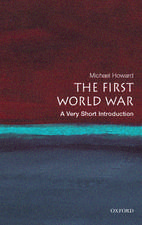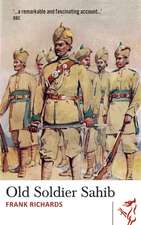The Art of Military Coercion: Why the West's Military Superiority Scarcely Matters
Autor Rob de Wijken Limba Engleză Paperback – 28 apr 2014
The United States spends more on its military than the rest of the world combined, and Western nations in general spend far more than developing nations around the globe. Yet when Western nations have found themselves in conflicts in recent decades, their military performance has been mixed at best. In this fully updated new edition of The Art of Military Coercion, Rob de Wijk explains this discrepancy through a theory on the use of force. He argues that the key is a failure to use force decisively and to understand properly the dynamics of conflict and balance, means and ends. Without that ability, even a superiority of dollars, numbers, and weaponry will not necessarily translate to victory.
Preț: 446.57 lei
Preț vechi: 485.39 lei
-8% Nou
Puncte Express: 670
Preț estimativ în valută:
85.46€ • 88.72$ • 71.26£
85.46€ • 88.72$ • 71.26£
Carte disponibilă
Livrare economică 03-17 martie
Livrare express 14-20 februarie pentru 34.05 lei
Preluare comenzi: 021 569.72.76
Specificații
ISBN-13: 9789089646743
ISBN-10: 9089646744
Pagini: 325
Ilustrații: 4 color plates, 4 halftones
Dimensiuni: 152 x 229 x 23 mm
Greutate: 0.54 kg
Ediția:Nouă
Editura: Amsterdam University Press
Colecția Amsterdam University Press
ISBN-10: 9089646744
Pagini: 325
Ilustrații: 4 color plates, 4 halftones
Dimensiuni: 152 x 229 x 23 mm
Greutate: 0.54 kg
Ediția:Nouă
Editura: Amsterdam University Press
Colecția Amsterdam University Press
Notă biografică
Rob de Wijk is director of The Hague Centre for Strategic Studies, chairman of the Dutch National Security Think Tank, and professor of international relations at Leiden University in the Netherlands.
Cuprins
Introduction (Second and Revised Edition)
Introduction (First Edition)
Introduction: Understanding Coercion
Military coercion, coercive diplomacy and political culture
Instruments of coercion
How this book is organized
Part I Political Culture: Why the West Coerces
1 A Western Civilization of Warriors?
Two cases: Iraq and Somalia
Realism, Idealism, and interventions
Western civilization
A universal and superior civilization?
The international legal order
Transatlantic differences in political culture
Conclusion
2 Liberal Democracies and Interventions
Democracy and the justification of interventions
Democratization and war
Democracies and interventions: the Cold War period
Democracies and interventions: the post-Cold War era
The decay of the non-intervention principle
America’s primacy
Conclusion
3 The Strategic Efficacy of Power Instruments
The theoretical foundation of coercion
Decision making
The instruments of coercion
The dynamics of coercion
Two strategies of coercion
Applications of military force in coercion strategies
Strategies and Opponents
Policy implications
Part 2 Strategic Culture: How the West Coerces
4 The Evolution of Modern Military Doctrine
Flexible response
Active defense
Interoperability
Attrition warfare versus maneuver warfare
The debate on active defense
The European reactions
AirLand Battle and NATO tactical doctrine
Follow-on Forces Attack
Doubts about the feasibility of AirLand Battle
The doctrinal mess of the 1990s
Lessons learned: the development of joint doctrine
New capabilities for full spectrum dominance
Two strategic cultures
Conclusion
5 Premodern Challenges and the Modern and Postmodern World
Trends explained
Interstate conflicts
Intrastate wars and complex contingencies
Non-state actors and the use of black holes
Religious anti-systemic terrorism
Biological and chemical threats
Nuclear and radiological weapons
Missile proliferation
Conclusion
6 Dealing with Complex Security Challenges
Western preoccupations
Savage warfare
Revolutionary warfare
Planning an operation
Special forces and intelligence
The Chechen wars
Operation Defensive Shield
Operation Cast Lead
Afghanistan: Operation Enduring Freedom
Afghanistan: the stabilization phase
Unified Protector (2011)
New doctrines
Operation Iraqi Freedom
Stabilization operations: reinventing population-centric COIN
Field Manual 3-24
NATO Doctrine
Measuring success in Iraq, Libya, and Afghanistan
Postmodern warfare
Conclusion
7 The Art of Military Coercion
The successful application of force
The principles of military operations
The timing of an intervention
Coalition warfare
Political preconditions
Public support
Concept of operations
Balancing means and ends
Military aid
Conclusion
Appendix
About the author
Introduction (First Edition)
Introduction: Understanding Coercion
Military coercion, coercive diplomacy and political culture
Instruments of coercion
How this book is organized
Part I Political Culture: Why the West Coerces
1 A Western Civilization of Warriors?
Two cases: Iraq and Somalia
Realism, Idealism, and interventions
Western civilization
A universal and superior civilization?
The international legal order
Transatlantic differences in political culture
Conclusion
2 Liberal Democracies and Interventions
Democracy and the justification of interventions
Democratization and war
Democracies and interventions: the Cold War period
Democracies and interventions: the post-Cold War era
The decay of the non-intervention principle
America’s primacy
Conclusion
3 The Strategic Efficacy of Power Instruments
The theoretical foundation of coercion
Decision making
The instruments of coercion
The dynamics of coercion
Two strategies of coercion
Applications of military force in coercion strategies
Strategies and Opponents
Policy implications
Part 2 Strategic Culture: How the West Coerces
4 The Evolution of Modern Military Doctrine
Flexible response
Active defense
Interoperability
Attrition warfare versus maneuver warfare
The debate on active defense
The European reactions
AirLand Battle and NATO tactical doctrine
Follow-on Forces Attack
Doubts about the feasibility of AirLand Battle
The doctrinal mess of the 1990s
Lessons learned: the development of joint doctrine
New capabilities for full spectrum dominance
Two strategic cultures
Conclusion
5 Premodern Challenges and the Modern and Postmodern World
Trends explained
Interstate conflicts
Intrastate wars and complex contingencies
Non-state actors and the use of black holes
Religious anti-systemic terrorism
Biological and chemical threats
Nuclear and radiological weapons
Missile proliferation
Conclusion
6 Dealing with Complex Security Challenges
Western preoccupations
Savage warfare
Revolutionary warfare
Planning an operation
Special forces and intelligence
The Chechen wars
Operation Defensive Shield
Operation Cast Lead
Afghanistan: Operation Enduring Freedom
Afghanistan: the stabilization phase
Unified Protector (2011)
New doctrines
Operation Iraqi Freedom
Stabilization operations: reinventing population-centric COIN
Field Manual 3-24
NATO Doctrine
Measuring success in Iraq, Libya, and Afghanistan
Postmodern warfare
Conclusion
7 The Art of Military Coercion
The successful application of force
The principles of military operations
The timing of an intervention
Coalition warfare
Political preconditions
Public support
Concept of operations
Balancing means and ends
Military aid
Conclusion
Appendix
About the author








